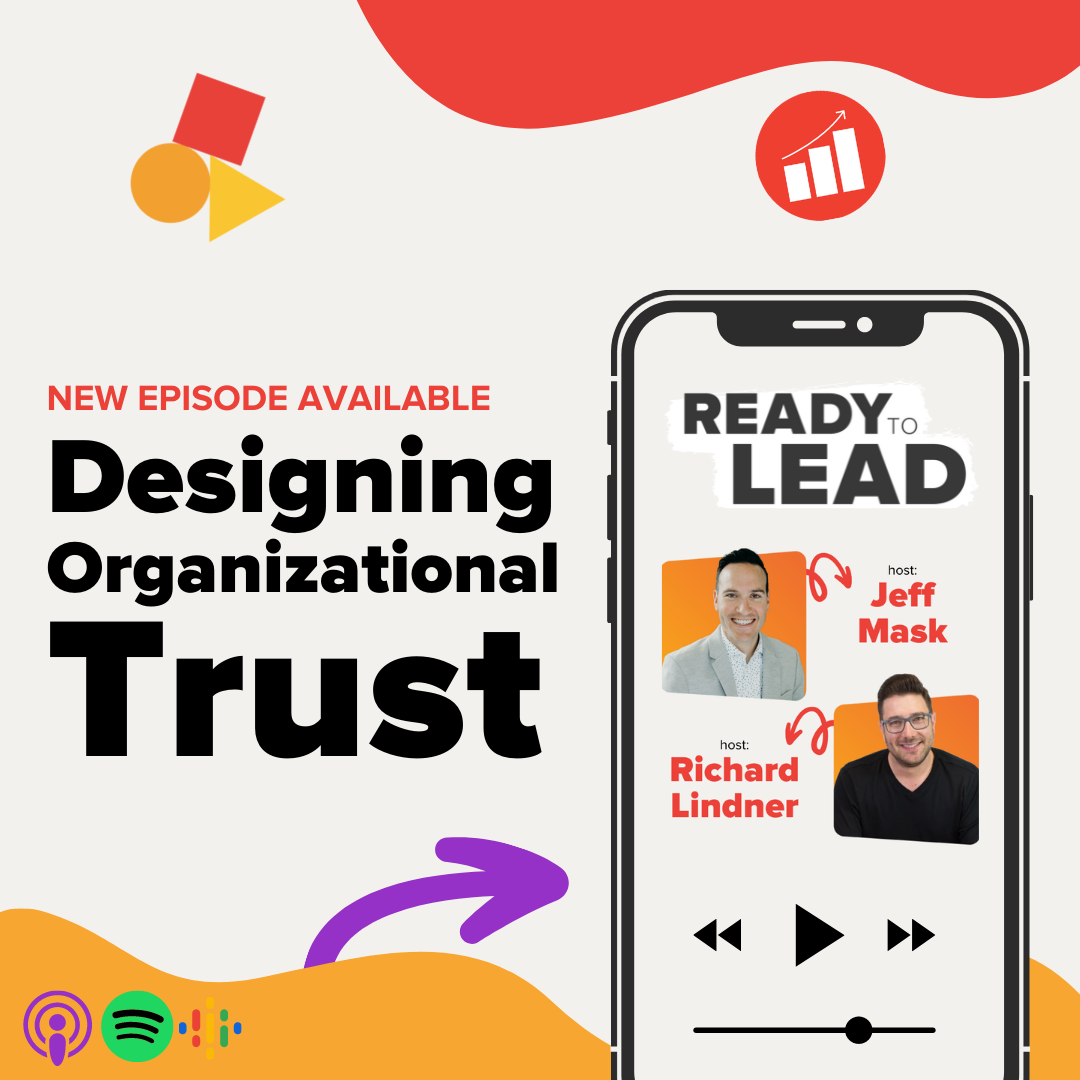Trust among coworkers has never been more important than it is in today’s virtual environment, and leaders have to intentionally design experiences that help build that trust.
As leaders, it can be tempting to bypass team building exercises and just get down to business already. There’s work to be done, goals to be met. Who has time for “shared experiences” and “team bonding,” right?
In today’s episode, co-hosts Richard Lindner and Jeff Mask build a solid case for why leaders can’t afford not to design trust-building experiences for their team. If you want to make an impact—and you want it to be enduring—you have to rally people to do their best work, or it won’t be sustainable. Your dreams and aspirations will crumble, and work will be a drag.
When you align people, connect with people, build deep strong relationships with people, the output is the best work of your career. You can accomplish way more, way faster, and more profitably when you have a strong foundation of trust.
Listen in for some great practical advice on designing organizational trust as a leader.
The 3 Levels of Trust-Building Experiences
To build trust with each other organically and consistently, you have to do it with a consistent cadence. You have to build these experiences into your company’s rhythm. But where do you start? How do you design these experiences? How do you develop the appropriate amount of intimacy based on the level of trust you have? You don’t want to do too much, too soon.
There are three types of experiences you can create as a leader, and they need to go in this order if you want to go at a good, healthy pace.
- shared experiences
- vulnerability-creating experiences
- healthy conflict experiences
Start with Shared Experiences
Shared experiences require no real relational equity. You could do a zipline together. Ride go-carts. Play a round of putt-putt golf. Tackle an obstacle course or an escape room. No one has to get vulnerable with anyone else. You just show up and play the game. Jeff recommends not going to a movie together. It’s better than nothing, but there’s not a lot of interaction. You’re just sitting there. Personalities don’t come out. There’s no struggle, no common goal.
A shared experience should incorporate a challenge of some kind. You’re architecting and engineering something in a non-work environment that mirrors what you’ll go through at work. You start together, struggle together, and emerge victorious at the end. You can have your trust at a level 0 out of 100 and get it up to 10 after this shared experience.
Richard’s leadership team does something called the Hot Wings challenge, which is Facebook-famous. The show interviews celebrities who have 10 hot wings in front of them, with sauces that build from “not that hot” to “oh my gosh why would anyone ever eat this?” Along the way, you’ll see the person’s mask coming off, bit by bit.
Richard’s team members take turns in the hot seat. When you want to talk about difficulty and shared experience and pleasure and pain, he says, this one’s loaded. You ask questions along the way like, “What would your wrestler name be?” It’s one thing to answer that question when you’re sitting around a table. It’s another to answer it when your eyes are watering, your lips are burning. It adds something to it.
He also suggests a board game like Apples to Apples. Jeff says jackbox.tv, Quiplash in particular, is great for when you can’t be together physically. These games provide time to get to know one another, share emotions, laugh, bond. It’s something you can anchor back to, reference time and time again as you’re working together.
Next Up: Vulnerability-Creating Experiences
You don’t jump into this category right away. Ease into it. Make sure you’ve got one or two shared experiences under your belt first. The personal history exercise by Patrick Lencioni is a good one. You go around the room and ask everyone the same three questions:
- Where were you born and raised?
- Where were you in the family’s pecking (birth) order?
- Tell us a meaningful experience from childhood that shaped who you are today.
Ideally, the leader goes first and is more vulnerable than they’d like to be. The point isn’t for everyone to break down in tears (but that does happen). The end goal is to share details where people say, wow, I never knew that. One of Jeff’s mantras is: “If I don’t like someone, I don’t know them well enough.” And this experience helps you get to know someone better.
Richard says it gives you new data points to reevaluate previous interactions. You can say, “Oh, when I thought this person was intending to make me feel a certain way, now I realize that’s just because they feel this…” You can change the narrative of how they made you feel with what you now know. Increased data = increased empathy.
You can also do what’s called a Life Plot exercise. The y axis top to bottom is high and low. The x axis is time. Plot your top 3 highest highs of your life and your 3 lowest lows. This shows you—and your team—what you’ve gone through and how resilient you are.
The Deepest Level: Healthy Conflict Experiences
A few years ago, Richard’s company flew Jeff out for one of their strategic offsites for their leadership team. He took them through an exercise called Trust Maker, Trust Breaker.
If you’ve built shared experiences, then had vulnerability conversations internally, now you can do them externally. Now, each person can go around the room and talk about each other. “Here are the things you do that build trust in our relationship. Here are things you do that break trust in our relationship.” You can see why you wouldn’t want to start with this exercise.
You as the leader have to model this, being even more transparent than you expect them to be. Who will give you strong feedback and see how you take it and respond? That will allow others to see this as a safe place.
Another activity you can do is what Jeff calls “Start, Stop, Continue” and Richard calls “Keep, Start, Stop.” You talk about what are we doing well, what are we not doing well, what do we need to keep, what do we need to start doing, and what do we need to stop doing? And you get really honest with each other and deal with any conflict that arises in a healthy, productive way.
Sometimes you need an outside facilitator for these things. You can’t fully participate and facilitate, and your team needs you to participate.
If you’ve never intentionally done a trust-building exercise with your team, schedule a shared experience for this quarter—or the next one. Then the following quarter, do a vulnerability experience. Then the next quarter, do a healthy conflict experience. You’re building trust intentionally and appropriately.
The Role Assessments Can Play
Assessments are another important thing to do with your team. There are two different types: Who I Am and How I Work. Myers-Briggs and DISC tell you more of who you are, while something like StrengthsFinder breaks down what type of work you’re good at, that energizes you. When you can align the work with the person’s personality, they’ll be on fire. But so often we mismatch that, because we just don’t know.
Richard says assessments are “slightly better than a horoscope.” In other words, don’t put all your stock in it. It gives you a third party with a standard rubric that is grading everybody the same way. It’s not perfect, but it allows us to have a conversation. Everyone does the assessment, sends them to the leader, then each person presents their own assessment. Share: here’s what I agree with, here’s what I’m unsure about, here’s what I disagree with. Then open it up to the rest of the room for their feedback.
The goal is getting to know who someone is. How do I better intentionally communicate with each person on my team? And how do I better receive communication from each person on my team because of what I know about them?
Don’t assume like everyone communicates like we do. It takes humility and self-awareness to recognize that. Take a backseat to your own personality and let other personalities shine. Don’t try to get everyone to conform to how you do things. Give other people the space to lead from their strengths.
How often should we be creating/leading these trust-building experiences? Richard believes you should do an experience and an assessment back to back quarterly. Jeff says to allocate more time than you think is necessary. You need at least 30 minutes per person to walk through assessments. Don’t cut people off when they’re sharing who they are. That’s the opposite of trust building.
Thank you for investing in leading others. When we take it seriously, it has a massive impact.
Richard and Jeff want to hear from YOU. Was something in today’s episode a big aha moment for you? Have you tried trust-building experiences? What has worked well? What hasn’t? What have you discovered about yourself and your team? Email them here with your thoughts/questions: feedback@readytolead.com
OTHER SHOWS YOU MIGHT ENJOY:
- Business Lunch with Roland Frasier and Ryan Deiss
- Perpetual Traffic with Ralph Burns and Kasim Aslam
- DigitalMarketer Podcast with Mark de Grasse


